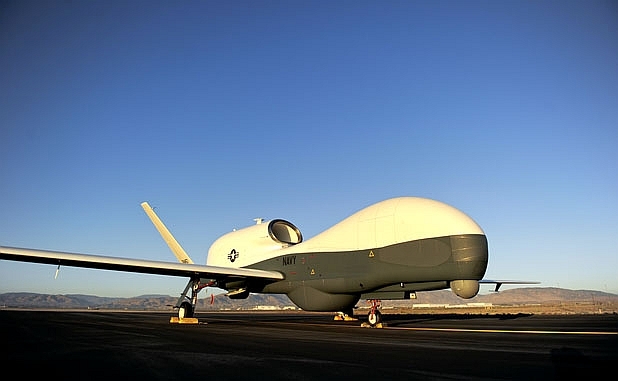The U.S. Navy continues to assess its options to replace a sense-and-avoid radar that was to be used on the Northrop Grumman MQ-4C Triton unmanned aircraft, but failed to meet expectations.

Exelis was selected by Northrop to provide the radar, but the Navy put a stop-work on the contract one year ago and began an assessment of alternatives. No alternative is available off the shelf, says Sean Burke, Navy deputy program manager. The problem was miniaturizing the advanced, electronically scanned array (AESA) radar technology and providing sufficient cooling and power within the available weight and space. It was a “technical solution that turned out to be very challenging for us,” Burke said.
“We are really at the edge of the technology” in developing the system, said Mike Mackey, Northrop Grumman’s Triton program manager. He and Burke briefed the media on the program during the annual Sea-Air-Space 2014 show hosted by the Navy League.
Navy officials are continuing to work on what they call an Airborne Sense-and-Avoid (ABSAA) capability for Triton. This includes a traffic collision avoidance system (TCAS) and use of Automatic Dependent Surveillance-Broadcast (ADS-B) for sense-and-avoid with “cooperative aircraft,” meaning those also using a similar system, according to Capt. Jim Hoke, Triton program manager for the Navy.
The TCAS and ADS-B systems are slated for introduction into the Triton in time for initial operational capability (IOC), which is slated for fiscal 2018. IOC consists of four air vehicles that will be deployed to a base on Guam; the U.S. Air Force’s Global Hawks also use this base.

However, the service has convened a panel of experts and “graybeards” to assess how to replace the capability that would have been offered by the Exelis sense-and-avoid radar. The company’s work remains on hold pending the outcome of this review.
Sense-and-avoid is needed for Triton to accommodate the Navy’s operational concept. Like the manned Lockheed P-3, the unmanned Triton will be required to dip below the clouds and marine layer to look at surface targets. The P-3 did this with onboard sensors and operators. Lacking onboard operators, the Triton will use its Raytheon MTS-B electro-optical sensor to surveil targets. But to do so, it must descend to a low altitude from the Global Hawk’s traditional operating altitude of 50,000 ft. or higher.
Meanwhile, the Navy is planning to deploy an early operational capability of two air vehicles in fiscal 2017. An operational assessment is slated for the fourth quarter of this year.
The program has been delayed a year due to technical risk, but Burke says the risk reduction done during that period has strengthened the plan moving ahead.
Triton is to be built on a structurally enhanced Global Hawk Block 30 platform; it will contain improved situational awareness technology, as well as new sensors tailored for the maritime mission and specialized equipment such as anti-icing systems on the wings and leading edges, including the engine inlets.
Initial envelope expansion testing for the air vehicle is complete, Hoke says. Only one of 568 test points had to be repeated, far below the standard 15% budgeted for reflying activities, says Rear Adm. Mat Winter, program executive officer for unmanned aircraft for the Navy. Should this trend continue, “I smell reduction in test and evaluation, verification and validation, and in the government’s back end” work for developing future aircraft systems such as the Unmanned Carrier-Launched Airborne Surveillance and Strike System (Uclass), or perhaps for the U.S. Marine Corps Boeing Insitu RQ-21 Blackjack program, Winter told Aviation Week.
Meanwhile, the AN/ZPY-3 Multi-Function Active Sensor (MFAS), the 360-deg. radar to be hung on the underside of Triton’s belly, is undergoing preliminary testing on a Gulfstream III. It is conducting its 37th flight test on April 8, Burke says.
Two additional Triton air vehicles are slated for first flight in June, after which all three will ferry to NAS Patuxent River, Md. The MFAS radar will be fitted onto an air vehicle there to commence integrated testing for the aircraft and its radar.
Australia has indicated it will likely purchase Triton; a commitment will be made based on performance of the forthcoming development work.
No comments:
Post a Comment